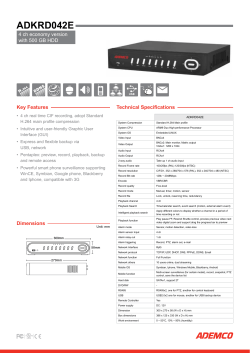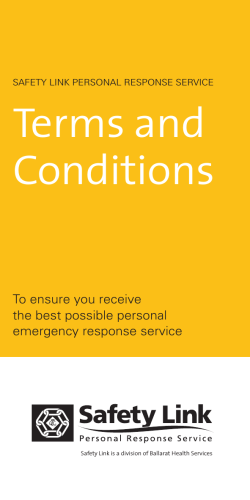
A Guide to Selecting a Personal Alarm Call System
A Guide to Selecting a Personal Alarm Call System A personal alarm call system is a safety device that allows a person to call for assistance when they are unable to access a telephone. How do they work? A personal alarm call system is a safety device that allows the user to call for assistance in an emergency when they are unable to access a telephone. It works by the person pressing a button on a pendant worn around their neck or wrist. Once the button is activated it sends a signal to a unit that is connected the home telephone line. A call is automatically sent to a designated contacted; this can either by through a monitored service (live call) or a nonmonitored service (autodialled with recorded message). Some Personal Alarm Call systems will also have the feature of working in the community, but rely on mobile phone network to access a telephone service. These systems are allowed for GPS (global positioning service) tracking for locating of people in the community. The details of where the person is located will be sent via and email or SMS with coordinates of their location, this requires the person monitoring them to have access to either a computer or a mobile phone that will allow them to convert the coordinates to a location. Guide to Selecting a Personal Alarm What is the difference? Monitored Service (ongoing fee) When the alarm is active the system is monitored 24 hours a day, 7 days a week. The monitoring station can identify the caller from the personal alarm unit it’s being registered too. The monitoring service will then activate the emergency plan that has been pre-arranged by the family/ user at the time of set up. This can include calling a list of support people or contacting emergency services. The systems: Can be purchased outright or rented Have ongoing monitoring fees Cost for set up 24 hour monitoring service Non-Monitored Service When the alarm is activated the system is dependent on the user having reliable contact person/s that can respond when the user presses the pendant. The unit begins dialling the first stored telephone number, from a list of phone numbers of support/ contact people which have been programmed into this unit in order of preference or availability (can be fixed line or mobile numbers). The contact person needs to acknowledge the caller (alarm system) is requiring help by pressing a designated button on their phone. Once this occurs, a pre-recorded message informs the contact person of the emergency. Each system has a different length or recording time; once the message is played it can not be recalled. It will NOT leave a message on voice mail. These systems are not designed to call 000 unless the manufacturer has specified this. Mobile Personal Alarm Call System (Ongoing cost using a mobile network) There is also a range of devices that can work in a similar way to a personal alarm system in the community. These include: • Wrist watches with mobile phone based emergency call and GPS tracking systems. • Simple mobile phones with SOS function (usually a separate button on the phone). • A personal tracking device that acts as a dual purpose, limited function mobile phone (calls out or in only) • They do not operate using the home landline. • The caller/user presses a button on the pendant / phone, this will call or send an SMS message or email to designated contacts in the pendant/phone that will be given a location of the user. • Most of these units have a two way talk back so they user can speak to their contact/support person via the pendant. • They operate using the mobile phone network which is an ongoing cost of using the service. • Some suppliers will assist with the set up of the system for an additional cost. Guide to Selecting a Personal Alarm The Independent Living Centre provides a free and impartial information and advisory service to help you choose the right product for you Factors to Consider: • What is the availability of support persons? • Will someone always be able to access your call? • How far away is your support person – how quick can they get to you for help? • How will they get into your home? – Keysafes coded keyboxes can be accessed by the contact/support person to allow access to the home. • How many users in the household? • Will it work during power outages? – does the system have battery backup? VOIP and hands free phones may not operate during power outages. • Mobile phone coverage/ network in your area? • Costs – this includes, cost of the initial product, cost of installation, and ongoing costs such as monitoring services or mobile phone services, costs of calls made. Replacement batteries and parts • Technical support – who will set it up? • After sales support • User ability – the user needs to be physically able and willing to activate the transmitter alarm, also consider their ability to follow instructions and process should the alarm be activated. • Funding options / rebates may be available. Some not all of the personal alarm call systems have these features: • Water resistance – most transmitters (excluding mobile phones/ watches) are splash proof, some have various water resistance abilities. • Multiple Transmitters – some systems can accommodate a number of transmitters for the same unit. • Range of Activation – most have a range that the transmitter will reach the unit (telephone) of 30-80metres. This is different for systems using the mobile phone network. • Some systems have fall detection sensors which registers if the person has fallen over. • Some systems also link in with smoke, gas, inactivity, or movement sensors (specialist) • Receiver unit – the unit is attached to a standard telephone line. Some of the units can replace and existing telephone (with accessible features such as amplified sound and bigger buttons). Some receiver units also have the option for two –way talk back. Guide to Selecting a Personal Alarm General Considerations: • Some non- monitored personal call systems can program 000, however there is no guarantee the response will even occur. Please check with the supplier to clarify if this has been an approved and tested function with emergency services. • In your message for a non-monitored system, state this is emergency call activation, include your name, address, phone number. Repeat the message a couple of times so the contact/support person can obtain the information clearly. • NBN (National Broadband Network) which is changing the fixed telephone system may affect the type of system you select. The battery back up time on the NBN is short and may affect the ability for the system to operate. Check with the supplier of the service to see if its system is compatible with NBN. • Make sure your equipment is set up correctly and test this in the early stages to make sure its functioning. Batteries in the unit and the pendant will have a finite time of use before they need to be replaced. Check this with the supplier. The Independent Living Centre of WA has a range of personal call alarm systems on display. If you wish to speak with an Occupational Therapist or book an appointment to come and see, please call.
© Copyright 2026











